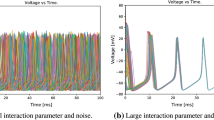Abstract
We study the loss of synchronization of two partially coupled space-clamped Hodgkin-Huxley equations, with symmetric coupling. This models the coupling of two cells through an electrical synapse. For strong enough coupling it is known that all solutions of the equations approach a state where the two cells are perfectly synchronized, having the same behaviour at each moment.
We describe the local bifurcations that arise when the coupling strength is reduced, using a mixture of analytical and numerical methods. We find that perfect synchrony is retained for very small positive values of the coupling strength, for almost all initial conditions. Although perfect synchrony is lost for negative values of the coupling constant, the system always retains some degree of synchronization until it becomes totally unstable. This happens in two ways: in many cases for almost all initial conditions the solutions still approach a perfectly synchronized state. Even when this is not true, the attracting solutions are still synchronized, with a half-period phase shift.
Similar content being viewed by others
References
Alves-Pinto, C., PhD Thesis, Universidade do Porto, Portugal (in preparation).
Buono, P-L. (2001). Models of central pattern generators for quadruped locomotion II. Secondary gaits. J. Math. Biol. 42, 291–326.
Buono, P-L. and M. Golubitsky (2001). Models of central pattern generators for quadruped locomotion I. Primary gaits. J. Math. Biol. 42, 291–326.
Farr, W. W., C. Li, I. S. Labouriau and W. F. Langford (1989). Degenerate Hopf bifurcation formulas and Hilbert’s 16th problem. SIAM J. Math. Anal. 20, 13–30.
Golubitsky, M. and W. F. Langford (1981). Classification and unfoldings of degenerate Hopf bifurcations. J. Differ. Eqns 41, 375–415.
Golubitsky, M. and D. G. Schaeffer (1984). Singularities and Groups in Bifurcation Theory, Vol. I, Springer.
Golubitsky, M. and I. Stewart (2002). The Symmetry Perspective: From Equilibrium to Chaos in Phase Space and Physical Space, Basel: Birkhauser.
Golubitsky, M., I. Stewart and D. G. Schaeffer (1987). Singularities and Groups in Bifurcation Theory, Vol. II, Springer.
Guckenheimer, J. and P. Holmes (1983). Nonlinear Oscillations, Dynamical Systems and Bifurcations of Vector Fields, Springer.
Guckenheimer, J., M. R. Myers, F. J. Wicklin and P. A. Worfolk (1995). Dstool: A Dynamical System Toolkit with an Interactive Graphical Interface, Center for Applied Mathematics, Cornell University.
Hassard, B. D. (1978). Bifurcation of periodic solutions of the Hodgkin-Huxley model for the squid giant axon. J. Theor. Biol. 401–420.
Hodgkin, A. L. and A. F. Huxley (1952). A quantitative description of membrane current and its application to conduction and excitation in nerve. J. Physiol. 117, 500–544. Reproduced in Bull. Math. Biol. 52, 25–71 (1990).
Labouriau, I. S. (1985). Degenerate Hopf bifurcation and nerve impulse. SIAM J. Math. Anal. 16, 61–71.
Labouriau, I. S. (1989). Degenerate Hopf bifurcation and nerve impulse, Part II. SIAM J. Math. Anal. 20, 1–12.
Labouriau, I. S. and C. Alves-Pinto (2003). Bifurcations in Symmetrically Coupled Hodgkin-Huxley Equations, Porto: CMUP (preprint # 2003-17, available at: http://www.fc.up.pt/cmup/).
Labouriau, I. S. and H. S. Rodrigues (2003). Synchronization of coupled equations of Hodgkin-Huxley type. Dynamics of Continuous, Discrete and Impulsive Systems, Series A—Mathematical Analysis 10 A, 463–476.
Rinzel, J. and R. N. Miller (1980). Numerical solutions of the Hodgkin-Huxley equations. Math. Biosci. 49, 27–59.
Terman, D. and E. Lee (1997). Partial synchronization in a network of neural oscillators. SIAM J. Appl. Math. 57, 252–293.
Author information
Authors and Affiliations
Rights and permissions
About this article
Cite this article
Labouriau, I.S., Alves-Pinto, C. Loss of synchronization in partially coupled Hodgkin-Huxley equations. Bull. Math. Biol. 66, 539–557 (2004). https://doi.org/10.1016/j.bulm.2003.09.006
Received:
Accepted:
Issue Date:
DOI: https://doi.org/10.1016/j.bulm.2003.09.006




